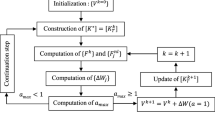Abstract
The aim of our work is the numerical modeling of two dimensional mechanical–thermal material mixing observed in stir welding process using a high order algorithm. This algorithm is based on coupling a meshless approach, a time discretization, a homotopy transformation, a development in Taylor series and a continuation method. The performance of the proposed model is the consideration of large deformations in the formulation of the posed problem. For the spatial treatment, we use the moving least squares approximation which will be applied directly to the strong form formulation of conservation equations. Each collocation point holds mechanical–thermal variables. The high order algorithm and the homotopy transformation allow reducing the number of tangent matrices to decompose and to avoid iterative procedure. Comparisons with the classical iterative solver (Jamal et al. in J Comput Mech 28:375–380, 2002) are performed. Numerical results reveal that a few number of matrix factorization is needed with the proposed approach, decreasing the computation time.











Similar content being viewed by others
References
Alfaro I, Fratini L, Cueto E, Chinesta F (2008) Numerical simulation of friction stir welding by natural element methods. Int J Mater Form 1(1):1079–1082
Alfaro I, Racineux G, Poitou A, Cueto E, Chinesta F (2009) Numerical simulation of friction stir welding by natural element methods. Int J Mater Form 2(2):225–234
Buffa G, Hu J, Shivpuri R, Fratini L (2006) A continuum based on fem model for friction stir welding model development. Mater Sci Eng 419:389–396
Canales D, Cueto E, Feulvarch E, Chinesta F (2014) First steps towards parametric modeling of fsw processes by using advanced separated representations: numerical techniques. Key Eng Mater 611–612:513–520
Cochelin B (1994) A path following technique via an asymptotic numerical method. J Comput Struct 53:1181–1192
Cueto E, Chinesta F (2015) Meshless methods for the simulation of material forming. Int J Mater Form 8(1):25–43
Fornberg B, Whitham GB (1978) A numerical and theoretical study of certain nonlinear wave phenomena. Philos Trans R Soc Lond A: Math Phys Sci 289:373–404
He X, Gu F, Ball A (2014) A review of numerical analysis of friction stir welding. Prog Mater Sci 65:1–66
Hirasawa S, Badarinarayan H, Okamoto K, Tomimurad T, Kawanami T (2010) Analysis of effect of tool geometry on plastic flow during friction stir spot welding using particle method. J Mater Process Technol 210(11):1455–1463
Jamal M, Braikat B, Boutmir S, Damil N, Potier-Ferry M (2002) A high order implicit algorithm for solving instationary non-linear problems. J Comput Mech 28:375–380
Lancaster P, Salkauskas K (1981) Surfaces generated by moving least squares methods. Math Comput 37(155):141–158
Mhada K, Braikat B, Hu H, Damil N, Potier-Ferry M (2012) About macroscopic models of instability pattern formation. Int J Solids Struct 49(21):2978–2989
Mottaqui H, Braikat B, Damil N (2010) Discussion about parameterization in the asymptotic numerical method: application to nonlinear elastic shells. Comput Methods Appl Mech Eng 199:1701–1709
Mottaqui H, Braikat B, Damil N (2010) Local parameterization and the asymptotic numerical method. Math Model Nat Phenom 5:16–22
Potier-Ferry M, Damil N, Braikat B, Descamps J, Cadou JM, Cao HL, Elhage Hussein A (1997) Traitement des fortes non linéarités par la méthode asymptotique numérique. Comptes Rendus de l’Académie des Sciences Paris 324(3):171–177
Haider A, Taqi AC, Ho-Sung Y, Younghae D, Cheol WP (2015) Numerical prediction of algae cell mixing feature in raceway ponds using particle tracing methods. Biotechnol Bioeng 112(2):297–307
Odin G, Savoldelli C, Boucharda PO, Tillier Y (2010) Determination of Young’s modulus of mandibular bone using inverse analysis. Med Eng Phys 32(6):630–637
Shivanian E (2016) More accurate results for two-dimensional heat equation with Neumann’s and non-classical boundary conditions. Eng Comput 32(4):729–743
Thomas WM, Nicholas ED, Needham JC, Church MG, Templesmith P, Dawes C (1991) Friction stir butt welding. International Patent Application no. PCT/GB92/02203 and GB Patent Application no. 9125978.8
Timesli A, Braikat B, Lahmam H, Zahrouni H (2015) A new algorithm based on moving least square method to simulate material mixing in friction stir welding. J Eng Anal Bound Elem 50:372–380
Timesli A, Braikat B, Zahrouni H, Moufki A, Lahmam H (2013) An implicit algorithm based on continuous moving least square to simulate material mixing in friction stir welding process. J Model Simul Eng 2013:14
Yoshikawa G, Miyasaka F, Hirata Y, Katayama Y, Fuse T (2012) Development of numerical simulation model for fsw employing particle method. Sci Technol Weld Join 17(4):255–263
Author information
Authors and Affiliations
Corresponding author
Ethics declarations
Conflict of interest
The authors, Said Mesmoudi, Abdelaziz Timesli, Bouazza Braikat, Hassane Lahmam and Hamid Zahrouni, declare that there is no conflict of interest concerning the publication of the article entitled “A 2D mechanical–thermal coupled model to simulate material mixing observed in friction stir welding process” and this article is original and never published. We look forward to hearing from you.
Rights and permissions
About this article
Cite this article
Mesmoudi, S., Timesli, A., Braikat, B. et al. A 2D mechanical–thermal coupled model to simulate material mixing observed in friction stir welding process. Engineering with Computers 33, 885–895 (2017). https://doi.org/10.1007/s00366-017-0504-3
Received:
Accepted:
Published:
Issue Date:
DOI: https://doi.org/10.1007/s00366-017-0504-3




